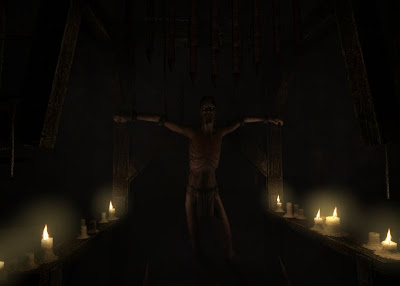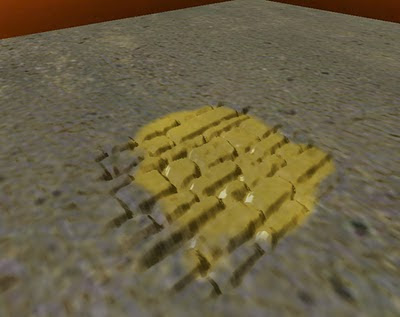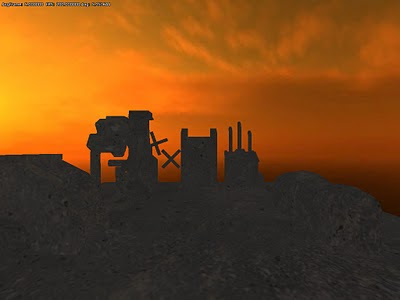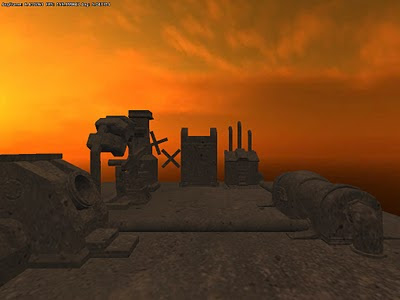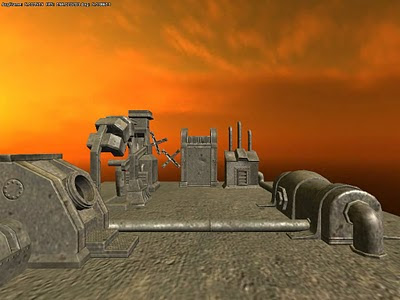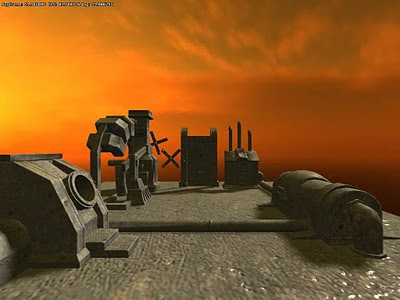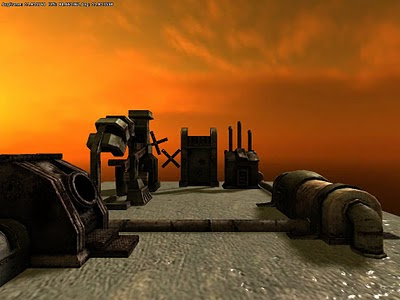 Introduction
IntroductionIt has now been pretty much exactly a month since we launched
Amnesia: The Dark Descent. And since the
post on a week after release was quite popular, we have decided to do a new overview on where we stand now. This time we will mainly focus on the sales and give some more accurate figures on how things have turned out for us.
The big pictureSo, with one month of data to analyze, how did things go? I think it can be summed up with:
Better than expected on all accounts! As of today we have sold a total of 36, 000 units (including pre-orders, but excluding boxed sales in Russia), and our goal, which would determine if we would continue or not, were 24,000. Having met and exceeded that goal already feels quite nice. Frictional Games will live to create another game!
15,000 (41.7%) of all sales were in the form of pre-orders, which is quite significant. Part of the explanation for this is that there was a 20% discount during pre-orders and we also believe that people are more inclined to buy a pre-order. With perks such as Steam pre-loading, people seem to think it is worth putting up money before release. And since there is no pirate alternative to a pre-order, it is more likely that people will go through with the purchase (more on pirating later). In any case, pre-orders is probably something we will focus on more for our next title.
Platform specificsGathering an exact percentage of sales for Linux turned out to be a bit complicated. Purchases made in our store gets all three platforms, which is the only place to get the Linux version. The total amount of sold units in our own store is about 5000. Since we can connect some of these sales with steam activations and similar, we can make a conservative estimate of 2500 Windows users, leaving 2500 left for Mac and Linux. And since this this is the only store for Linux users, we assume 70% of these are Linux. This means 1750 sold Linux units, or 5% of the total sales.
Mac sales are a bit simpler to estimate, and given the estimates from above plus some other data, comes to about 8% of the total sales. The interesting bit here is that just taking the last week into account the amount of mac sales lie at about 12%. This probably means that the Mac market takes longer to penetrate and that Mac owners might be more likely to buy an "old" game. Unfortunately we do not have data regarding this for Linux, but assume something similar happens there.
Media and user responseAs we said in the
last post, the response from the media and users have been overwhelming to say the least. Right now, we have 86% at
Metacritic, 90% from users on
Gamespot, and so on. Considering it is a niche and story based game this feels extra nice (which, as Kieron Gillen
points out on RPS, usually get lower meta-scores). We could not be any happier than we are with this response.
So how has this affected the sales? Well it is obviously impossible to say what we would have sold with worse grades, but what we can do is to see what correlations there are between positive reviews and spikes in sales. It turns out there is pretty much none. The only correlation we managed to find was with combined release of the
Zero punctuation and
Gamespot reviews. These were out very close in time and almost quadrupled sales compared to the previous days before (about 150/day to 600/day). It even seems like this boost still remains.
Apart from this example, it has not been possible to find any other correlations. Part of this is probably due to the noisy nature of the data; many reviews come out at the same time they overlap and it is not possible to discern individual contributions. However, when articles have been alone in time, there still have not been any noticeable spikes. One explanation is that it might be hard for people to find out where the game is bought, as our website is seldom mentioned in previews/reviews. This is especially true for the time before the pre-order became available at the major online retailers. Another explanation is that most reviews have more of a long term effect, instead of an instant sales boost. What this means is that reviews convince players that already know about the game to purchase it, instead of acting as a PR catalyst.
What reviews does do is to make other publications find out about you. Getting a review in a high-status outlet have meant mails from many other publications and convinced other media folk that the game is worth writing about. Thus, as mentioned previously, good review help sales in a long term perspective.
PiratingNow it is time to discuss pirating and how this has affected us. First of all, it is quite easy to see that there are tons of torrents/shared files of Amnesia available. When we search the web to see if any news on Amnesia has popped up, almost 50% of the results go to a pirated version of the game. This is of course makes us sad, but it is also something one has to deal with when living in today's world. We are well aware that the same technology that allows pirating of our game, is the same that enabled us create the game in the first place. Without a fast Internet and a connected world we would never be able to work together or distribute our games. But this does not mean that we should just ignore piracy and it is important to figure out what kind of impact it has on us.
As I have said, the sales have been above what we had expected, but compared to the response we have gotten it still feels kind of low. For example, the very hyped
Minecraft has gotten
more than ten times the sales compared us. While being a vastly different game compared to Amnesia, there are some differences that are worth discussing. In terms of the amount of PR received, I would say that Minecraft is more well known, but Amnesia is not far behind. Google gives us two times the hits compared to them and a popular pirate site gives Minecraft double the distributors compared to us. We have gotten more reviews from popular outlets, Minecraft has gotten more viral-like PR. As I said, I think Minecraft has the upper hand here, but not by that much. Still, Minecraft has a over ten times the sales compared to Amnesia, which is a huge difference.
Our conclusion is that a large part of this is due to the lack of pirating in Minecraft compared to us. As I mentioned above, Minecraft has 10x the sales, but only 2x the torrent distributors. A Google search on the subject also turns up twice the hits for Amnesia. It seems like more people are pirating Amnesia and we think there are two main reasons for this. Both of them are related to the single-player nature of the experience.
First of all, once you have played Amnesia there is little meaning to play again. A person pirating the game and finishing it has no real reason to go back. So even if a player likes it and determines that it is well worth paying for, there is no incentive to do so. It is quite common to read on forums that people have downloaded a pirated version and say that they will probably buy it later. The question here is how many actually does this? Even if you really liked the game and want to support the developers, it basically feels like money down the drain since you get nothing extra after paying. This is not the case for a game like Minecraft where more content is released all the time and the game is designed to be highly replayable (and darn it for that, damn time consumer!).
The second reason is the lack of any proper protection. Not only does Amnesia not have any real protection from the start, there is almost no way for us to force people into buying ad-hoc. What we can do is to release patches, but this only affect people that have not been able to start the game, a small part of the user base. So once the game is out we are basically screwed and we can not do much to make people chose a legal over a pirated one. Minecraft requires a server connection and is constantly updated, effectively pushing people towards buying the legit version.
So what to do about this? One way is to create different kinds of games, where we can implement these sort of things. But that just feels wrong. A developer should not design a game based on how it can be protected and doing so can only lead to bad things for our games (to avoid feeding potential flames; this is based on what we want to do with our games, not what we think of others who might do this). What we want to continue doing is to create single player games that try to evolve the way in which videogames tell stories and evoke emotions. Another option is to expand our horizons and try other platforms. This is what we are currently looking into. We do not know what this will mean as of yet, but hopefully we can continue to expand platforms and not limit them.
Our situationSo what does all this money talk mean for Frictional Games as a company? The most positive news is that we have recouped all expenses from creating Amnesia. This is of course awesome, but it needs to be taken into account that we worked long days at a very low salary, using minimal expenses. Our next game will not be possible to do on a budget like that.
For the team, it is now finally back to more normal salaries. This still means that we are paid below, or just at, minimum wage (there is not an actual minimum specified by law, we just mean according to standards) here in Sweden though. We have made some calculations and if we were to increase salaries to normal levels, our current earnings would only last for a year and a half at most. We estimate that it will take at least two years to complete our upcoming game and there are more expenses involved than salaries for the five team members (check the credits for Amnesia!). So right now, we have to stick to having low salaries and see how sales pan out.
At the time of writing our daily sales are at around 350 units, but it fluctuates quite a bit and it is hard to see how it will be in the long term. I said in the
previous post that the sales were dropping drastically, but this actually stopped a day or so after posting. Our hope is that it will end up at around 70 per day, as this means that the day-to-day sales would cover monthly salary costs. The money earned at launch could then be used for other expenses and perhaps help us reach more common wages. Very hard to say when a steady level will been reached though. For the Penumbra games it happened two weeks or so after release, but PR for Amnesia is still pouring in, so we assume at least another month.
Final thoughtsHopefully this post has give some kind of insight into sales for a PC game and where Frictional Games stand now. We are really happy how Amnesia have turned out in all ways. While sales could have been better, people are still buying it and will hopefully continue to. If it stabilizes at a good level, things are looking very bright indeed.
We also feel that we finally can leave Amnesia behind us and start focusing on our next project instead. As this will be our first project where we know from the start that we can finance it ourselves, it will be very interesting to see what can be done. In all our previous games, we have mostly rushed through the production. This is will be the first time we can take our time and make sure that all is the way we want it to.
Exciting times lie ahead and we hope you all will follow us into the future as well!
 First of all we have to recommend our own creations that are now available at a very low rate! Amnesia and Penumbra can both be gotten for as low as 50% the price on several online stores. Right now discounts are available at Our Own Store, Steam, GamersGate, ImpulseDriven and the voices tell me Direct2Drive will have discount very soon too.
First of all we have to recommend our own creations that are now available at a very low rate! Amnesia and Penumbra can both be gotten for as low as 50% the price on several online stores. Right now discounts are available at Our Own Store, Steam, GamersGate, ImpulseDriven and the voices tell me Direct2Drive will have discount very soon too. At Halloween all kinds of crappy horror movies are released, so to save you from that here are some films that you might have missed:
At Halloween all kinds of crappy horror movies are released, so to save you from that here are some films that you might have missed: Nothing can tingle the imagination as a good book. So here are some tips on how to invoke those nightmares I bet you long for.
Nothing can tingle the imagination as a good book. So here are some tips on how to invoke those nightmares I bet you long for.



